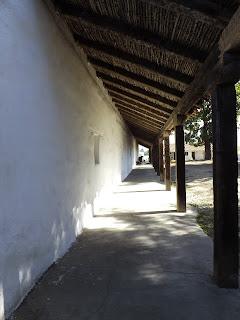The 21 California missions were
the first permanent European settlements to be founded on the West coast,
beginning in 1769.
The mission was founded on August 28, 1791 by Padre Fermin Lasuen, and named for the feast of the Exultation of the Cross. The mission was flooded as the San Lorenzo swelled with the rains that winter. Over the next two years, the padres set out to rebuild the mission on the hill overlooking the river. The night of December 14, 1793, Mission Santa Cruz was attacked and partially burned by members of the Quiroste tribe who inhabited the mountains to the east of Point Año Nuevo. The attack was purportedly motivated by the forced relocation of Indians to the Mission. The mission was looted in 1818 by the residents of the nearby pueblo of Branciforte after the mission's inhabitants fled under threat of pirate attack by Hypolite de Bouchard. The front wall of the adobe mission, built in 1794, was destroyed by earthquakes in 1857. A wooden facade was added and the structure converted to other uses.
The mission was founded on August 28, 1791 by Padre Fermin Lasuen, and named for the feast of the Exultation of the Cross. The mission was flooded as the San Lorenzo swelled with the rains that winter. Over the next two years, the padres set out to rebuild the mission on the hill overlooking the river. The night of December 14, 1793, Mission Santa Cruz was attacked and partially burned by members of the Quiroste tribe who inhabited the mountains to the east of Point Año Nuevo. The attack was purportedly motivated by the forced relocation of Indians to the Mission. The mission was looted in 1818 by the residents of the nearby pueblo of Branciforte after the mission's inhabitants fled under threat of pirate attack by Hypolite de Bouchard. The front wall of the adobe mission, built in 1794, was destroyed by earthquakes in 1857. A wooden facade was added and the structure converted to other uses.
Santa Cruz ranked in the bottom
25% of the California Missions in the size of its livestock herd (9,236 in
1832). Approximately 75,000 bushels of
grain and produce were produced over the active life of the mission.
The current Gothic-style Holy
Cross Church was built on the site of the original mission church in 1889, and
it remains an active parish of the Diocese of Monterey. In 1931, Gladys
Sullivan Doyle proposed to construct a half-size replica of the original
Mission next door to the modern church. She contributed all of the construction
costs, on the condition that she would be buried inside. Her grave can be
viewed in a small side room. The small replica chapel is mainly used for
private services for the Holy Cross Church. An adjoining room functions as a
gift shop. A stone fountain from the original mission complex stands in the garden
behind the gift shop. The original
mission church, whose bell tower collapsed in 1840, contained nine or ten
bells, none of which have survived. The mission replica has a 20th century bell
hanging in tower.
Today's Plaza Park occupies the
same location as the original plaza, at the center of the former Mission
complex. The complex at one time included as many as 32 buildings. The first
autopsy in California was performed at this mission on Fr. Andres Quintana in
1812, to determine the cause of his death (the neophytes were suspected of
having murdered him).
The only surviving Santa Cruz
Mission building has been restored to its original appearance and functions as
a museum of the Santa Cruz Mission State Historic Park: this portion of the
adobe, built in the early 1800’s, had been Indian family housing, the only
example of its kind still standing in California today.
Learn more about the missions and other great places to
visit along the coast in “Along the King’s Road: A Guide to Touring the California
Missions.” Get your copy!




No comments:
Post a Comment
You are invited to join the conversation!
Please keep the following in mind when posting your comments:
- You do not need to register to comment
- You may comment anonymously
- You may post questions, and I will do my best to respond in a timely fashion.
- You may disagree. But please do so respectfully.
- I reserve the right to delete inappropriate or rude comments.
- You are the sole owner of your comments.
- You grant me license to publish your comments in another venue, royalty free and without limitations, including in a blog, book, video, or presentation.